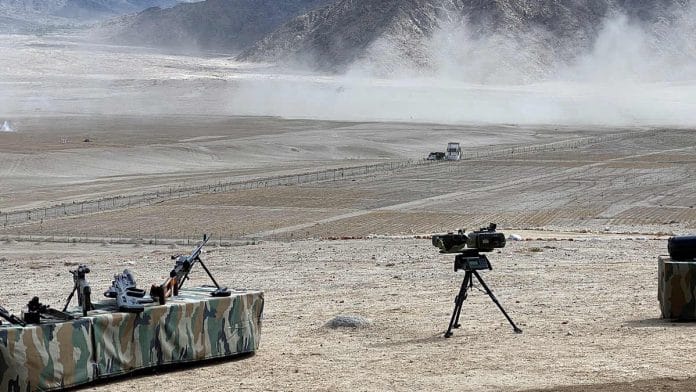New Delhi: In what is expected to amplify the secure communication network of the Army in the sensitive forward operational areas, including at the Line of Actual Control (LAC) in eastern Ladakh, the Cabinet Committee on Security (CCS) has approved a proposal to establish the Phase 4 of the Army Static Switched Communication Network (ASCON).
The project will be implemented by Public Sector Undertaking ITI at an estimated cost of Rs 7,796.39 crore.
ThePrint has learnt that the approval came a few weeks ago, but the government issued a statement in this regard Thursday.
According to the statement, the project will provide better survivability, responsiveness and high bandwidth in any operational scenario and enhance the communication coverage of the network closer to the International Border (IB), Line of Control (LoC) with Pakistan and the LAC with China.
“The network will extend the high bandwidth communication to the remote operational areas in Central and Eastern Sectors and enhance communication reach to the forward locations in the Western border too,” it said.
“… the project would augment the communication network of Indian Army in the sensitive forward operational areas, which in turn will provide a major boost to the operational preparedness of the Indian Army, especially keeping in view the current operational situation at LAC,” it added.
The development comes amid reports that China is laying a network of optical fibre cables at areas south of Pangong Tso in Ladakh.
Lt Gen. Nitin Kohli (retd), former signal officer-in-chief, told ThePrint the move will help tremendously in covering the gaps left by the earlier three phases and improve the operational communication of the Army both during an operation and in peacetime.
“This will be highly reliable and secure, state-of-the-art, multimodal, high bandwidth communication,” the former senior officer said.
Talking about the technology, he said, while optical fibres would be laid in areas that are feasible for it, in areas where the terrain is rugged and where it is physically impossible to lay the cables, Microwave Radio and Satellite Communication, among others, will be used for the communication.
“It will also ensure a robust 24X7 communication network which won’t be affected by the weather or terrain,” he said, adding that previous technologies are upgraded by the Army periodically.
“With implementation of this project, almost the entire country will be covered by the ASCON network,” he added.
Also read: Indian soldiers at LAC have go-ahead to open fire in self-defence, India tells China
‘Will strengthen the core of strategic communication’
The first phase of the project began in 1985-86, which covered major cities. Phase 2 of the project was implemented in the mid-90s. The third phase of the project covering western borders was implemented between 2005 and 2007.
A second Army officer explained that the project will mark the upgradation of existing ASCON network, particularly towards the LoC and LAC, as IB was already covered in phase 3 of the project.
“This will strengthen the core of strategic communication as the connectivity from these nodes will extend to the forward locations,” the officer said, adding that this will boost the services’ bandwidth requirements amid increased demands by making the network ready for the future.
It will also go a long way in filling up NFS gaps, the officer said.
NFS or Network for Spectrum refers to a dedicated communications network, which the telecom department is setting up for the defence forces and is being implemented by the BSNL.
The government statement said the implementation schedule of the project will be 36 months from the date of signing of the contract.
“The contract has been signed with M/s ITI Ltd on 01.10.2020. The project is a strategic and theatre area communication network, which will upgrade the existing Asynchronous Transfer Mode Technology to Internet Protocol (IP)/Multi Protocol Label Switching (MPLS) Technology,” the statement said.
“Optical Fibre Cable (OFC), Microwave Radio and Satellite will be used as communication media,” it added.
It also stated that with approximately 80 per cent indigenous content, the project will provide a boost to the Indian industry.
It said the project involves execution of civil works, laying of OFC, tower construction, etc. and with utilisation of local resources and hiring of manpower, it would generate employment opportunities especially to the people in remote border areas.
“The project is also a big opportunity for the public sector to showcase its capability and provide an impetus to the Indian economy and will be a step in the direction of achieving the goal of Atmanirbhar Bharat,” it added.
Also read: Why LAC could end up like LoC with more Indian Army deployment after China tensions ease






